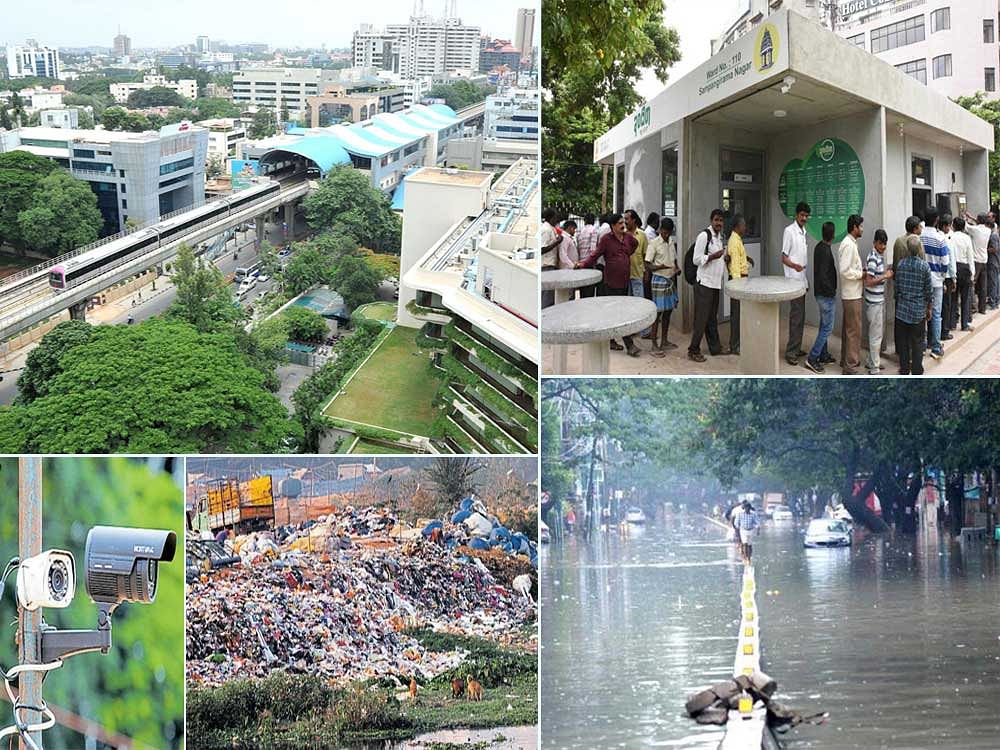DH 2017: Bengaluru! you're at POINT BLANK: The fall and the rise of the city
Last Updated IST

DH 2017: Bengaluru! you're at POINT BLANK: The fall and the rise of the city
Bengaluru is stepping into an incipient year. At this point, it is essential to reflect on the events that shaped Bengaluru this past year. Bengaluru is becoming more popular across the world and its magnetized infrastructure development like Namma Metro and Indira canteen have made people life more facile. Concurrently, the growing city traffic, flood, crimes have made havoc in the city.
DH brings you a few of the news from the city which transmuted the lives of people and transformed the city itself.
Construction debris and solid waste are being dumped, some under the cover of darkness and some openly. Several rivers in the city have been transformed into garbage dumping yards.
The encroachment pattern is similar across water bodies: Debris is dumped surreptitiously or otherwise; mud is overlaid and the land compressed over months.
The city could now hope for protected heritage sites to cherish the monuments that have weathered centuries of changes and development. The Bangalore Development Authority's Draft Revised Master Plan-2031 imposes development restrictions in 12 heritage zones, apart from listing out 558 heritage sites for the first time.

BBMP Commissioner N Manjunath Prasad has listed these lessons that the Palike has learnt from what the city suffered this season. Stricter norms for road contractors: From now on, says the commissioner, there will be stricter norms for contractors who undertake the road work. "If we find that a road is damaged before the maintenance period, the contractor will be blacklisted,” he warns.
Not long ago, parents would remain worry-free as their children left for schools early in the morning and returned late in the afternoon. But today, they are tormented by worrying thoughts about the safe return of their young ones. They are unnerved by recent cases of child abuse and deaths reported from schools across the country.
The weathermen could not warn the public about the record rains, which could have helped them take precautions. Despite giant strides in satellite-based weather forecasting technologies, Bengalureans had to depend on generalised statements from the Meteorological Departments.
There have been arguments in favour of keeping highways free from the pub menace. A regular, heavy drinker would keep stock in his or her vehicle, but it is better not to attract an occasional drinker towards liquor with an outlet on the way.
Many areas in the city have turned accident-prone zones due, primarily, to a large number of private buses violating traffic rules. The police list out common complaints against private buses: Wrong parking, stopping buses on roads to pick up passengers, overspeeding, signal-jumping, pick-up point on congested roads, competing with rival operators and government buses, besides overloading.
Trapped in the cross-fire of cultural divisions, are African students in Bengaluru getting stereotyped? Are local communities who complain about the misdeeds of a few students unfairly branded as racist? Or is there a genuine chance for consensus, reconciliation and better understanding?
Spot a criminal in his act and track him with that visual footprint. Packing Bengaluru’s Central Business District (CBD) streets with CCTVs, the city police are revving up their surveillance game. But how does that work in those dark, desolate roads on the city’s outskirts? Danger lurks in every corner for thousands of working women walking that last mile home.
Frothing and burning, Bengaluru’s biggest waterbody, the Bellandur lake had shot off another warning sign of its terminal illness. Polluted well beyond half-hearted redemption efforts, the lake’s message was unquestionably clear: Long stuck in planning, the revival plans had to take off.
Namma Metro, with its clean stations, coaches and punctual schedule might have given a different image to public transport, but the reality remains: The system caters to only a fraction of the city. Huge swaths of the city still have to make do with a not-so-tightly managed and visibly outdated system of BMTC buses.
(Compiled by Dalu Jose)